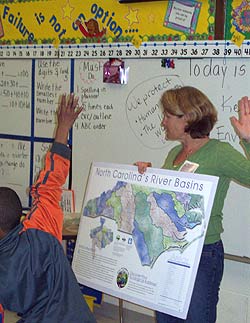What Would YOU do with $1 Million and an Acre of Riverfront Property?
Friday, January 30th, 2009About the author: Kelly Leovic works in EPA’s National Exposure Research Laboratory and manages the Environmental and Community Outreach Program in Research Triangle Park, N.C.
I asked this question to the 3rd grade class at Y.E. Smith Elementary School at EPA’s Science Day on December 5th. EPA began hosting the annual Science Day at the downtown Durham school in 2004 as part of our outreach efforts to inspire students’ interest in science and the environment.
Twenty-two EPA employees, as well as four community volunteers, participated in EPA’s Science Day, by teaching hands-on environment science activities. Each presenter shared their lesson with three classes, linking their activities to the N.C. Standard Course of Study to supplement the grade level curriculum. Topics ranged from geology to energy consumption to water quality.
 So, getting back to my 3rd graders…I give each student a fake $1 million dollar bill, a “piece of land,” and colored pencils to draw what they would build on their riverfront property with their million dollars. The idea is that each student’s piece of land is part of the ecosystem and what one person does on their land can affect others as the pieces are assembled. The activity is called “Sum of the Parts” and is from Project WET. As the students complete their million-dollar drawings, we put together the pieces of the river “puzzle” on the floor and then brainstorm about the types of water pollution that could come from what they built on their property. Types of pollution included run-off, litter, oil from boats, fishing line, and my personal favorite, sewage, which I referred to as pee and poop. We then begin to talk about how upstream development and the resulting pollution can affect those downstream.
So, getting back to my 3rd graders…I give each student a fake $1 million dollar bill, a “piece of land,” and colored pencils to draw what they would build on their riverfront property with their million dollars. The idea is that each student’s piece of land is part of the ecosystem and what one person does on their land can affect others as the pieces are assembled. The activity is called “Sum of the Parts” and is from Project WET. As the students complete their million-dollar drawings, we put together the pieces of the river “puzzle” on the floor and then brainstorm about the types of water pollution that could come from what they built on their property. Types of pollution included run-off, litter, oil from boats, fishing line, and my personal favorite, sewage, which I referred to as pee and poop. We then begin to talk about how upstream development and the resulting pollution can affect those downstream.
Most of the 3rd graders built huge houses; some even drew “mansions.” Having done this activity with students of all ages, I always enjoy seeing their creativity followed by their recognition that consumption can affect the environment. In comparison, middle schoolers like to build malls and shoe stores, and adults tend toward solar homes and organic gardening. Regardless, “Sum of the Parts” is always a hit because it encourages the students to think about the impact of their personal activities on the environment. Plus, it gives them the opportunity to be creative with their drawings, and, much to their delight, they get to keep the fake $1 million!
To learn more about past EPA Science Days, go to the Durham Public Schools Partners in the Community link at http://www.dpsnc.net/channel-4/partners-in-education/epa-science-day. If you are located in the Research Triangle Park area and would like to have EPA come speak at your school or to your community group, check out our Speakers Bureau at www.epa.gov/rtpspeakers. Speaking topics include air quality, climate change, sustainability, and water quality, as well as science fair judging.

 Each week we write about the science behind environmental protection.
Each week we write about the science behind environmental protection.  I gazed over the podium at the Portuguese faces waiting to hear how the U.S. EPA measures the health of U.S. estuaries and coastal oceans. A conference in the Azores was comparing the approaches used by the U.S. and the European Union (EU). A few opening pleasantries quickly exhausted my what-you-can-learn-from-ten-CDs knowledge of the Portuguese language and I switched to English.
I gazed over the podium at the Portuguese faces waiting to hear how the U.S. EPA measures the health of U.S. estuaries and coastal oceans. A conference in the Azores was comparing the approaches used by the U.S. and the European Union (EU). A few opening pleasantries quickly exhausted my what-you-can-learn-from-ten-CDs knowledge of the Portuguese language and I switched to English. A few months ago, my wife and I bought a house slightly bigger than our current home, but organized inside in pretty strange ways. Since we plan to spend the next 30-40 years there, we decided to renovate it. We want to do it in the greenest way possible. That means reduce, reuse, and recycle through the renovation.
A few months ago, my wife and I bought a house slightly bigger than our current home, but organized inside in pretty strange ways. Since we plan to spend the next 30-40 years there, we decided to renovate it. We want to do it in the greenest way possible. That means reduce, reuse, and recycle through the renovation.